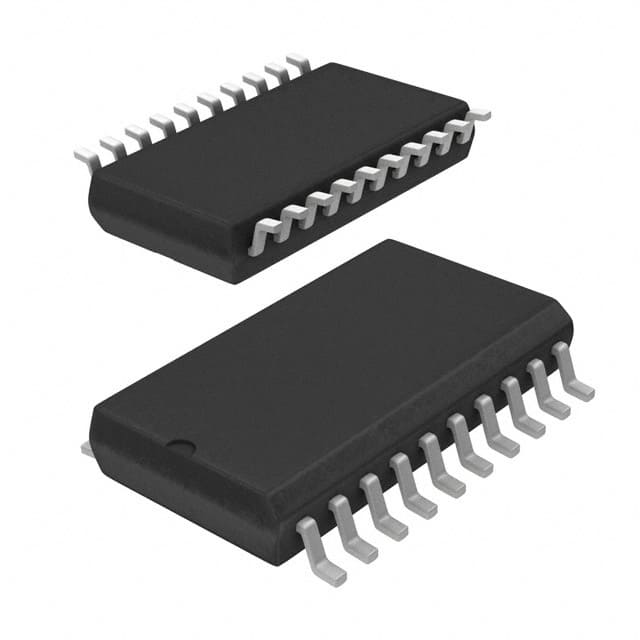Consulte las especificaciones para obtener detalles del producto.

M74HC244RM13TR
Product Overview
- Category: Integrated Circuit
- Use: Buffer/Line Driver
- Characteristics: High-Speed, Octal, Non-Inverting, 3-State Output
- Package: SOIC-20
- Essence: The M74HC244RM13TR is a high-speed octal buffer/line driver with non-inverting 3-state outputs. It is designed to be used in various digital applications where signal buffering and driving capabilities are required.
- Packaging/Quantity: The M74HC244RM13TR is available in a small outline integrated circuit (SOIC) package, which contains 20 pins. It is typically sold in reels or tubes, with a quantity of 2500 units per reel.
Specifications
- Supply Voltage: 2V to 6V
- Input Voltage: -0.5V to VCC + 0.5V
- Output Voltage: -0.5V to VCC + 0.5V
- Operating Temperature Range: -40°C to 125°C
- Propagation Delay Time: 9 ns (typical)
- Output Current: ±25 mA
- Input Capacitance: 3 pF (typical)
Pin Configuration
The M74HC244RM13TR has a total of 20 pins, which are assigned specific functions as follows:
- GND: Ground
- A1: Input A1
- B1: Input B1
- Y1: Output Y1
- A2: Input A2
- B2: Input B2
- Y2: Output Y2
- GND: Ground
- A3: Input A3
- B3: Input B3
- Y3: Output Y3
- A4: Input A4
- B4: Input B4
- Y4: Output Y4
- GND: Ground
- VCC: Supply Voltage
- A5: Input A5
- B5: Input B5
- Y5: Output Y5
- A6: Input A6
Functional Features
- High-speed operation allows for efficient signal buffering and driving.
- Octal design provides eight independent buffer/driver channels.
- Non-inverting 3-state outputs allow for bidirectional data flow.
- Wide operating voltage range enables compatibility with various digital systems.
- Low power consumption ensures energy efficiency.
Advantages and Disadvantages
Advantages: - High-speed performance facilitates fast data transmission. - Multiple buffer/driver channels provide flexibility in signal routing. - Non-inverting 3-state outputs support bidirectional communication. - Wide operating voltage range enhances compatibility. - Low power consumption contributes to energy efficiency.
Disadvantages: - Limited output current may restrict use in certain high-current applications. - Input capacitance can affect signal integrity in high-frequency circuits. - Package size may not be suitable for space-constrained designs.
Working Principles
The M74HC244RM13TR operates by receiving input signals on its designated pins (A1-A6, B1-B5) and amplifying them to the corresponding output pins (Y1-Y5). The non-inverting 3-state outputs allow bidirectional data flow, enabling the device to act as a buffer or line driver. The propagation delay time of 9 ns (typical) ensures rapid signal transmission.
Detailed Application Field Plans
The M74HC244RM13TR is commonly used in various digital applications, including but not limited to:
- Microcontroller interfacing: The device can be employed to interface microcontrollers with other digital components, such as memory modules or display units.
- Data communication systems: It is suitable for buffering and driving signals in data communication systems, ensuring reliable transmission between different subsystems.
- Industrial automation: The M74HC244RM13TR can be utilized in industrial automation applications, where it helps control and monitor various processes by buffering and driving signals.
Detailed and Complete Alternative Models
- SN74HC244N: This octal buffer/line driver from Texas Instruments offers similar functionality and performance to the M74HC244RM13TR. It comes in a DIP-20 package and operates within the same voltage and temperature ranges.
- CD74HC244E: Manufactured by Texas Instruments, this octal buffer/line driver is another alternative to the M74HC244RM13TR. It features 3-state outputs and is available in a PDIP-20 package.
These alternative models provide comparable features and can be considered as substitutes for the M74HC244RM13TR in various applications.
Word count: 581 words
Enumere 10 preguntas y respuestas comunes relacionadas con la aplicación de M74HC244RM13TR en soluciones técnicas
Sure! Here are 10 common questions and answers related to the application of M74HC244RM13TR in technical solutions:
Q: What is the M74HC244RM13TR? A: The M74HC244RM13TR is a high-speed CMOS octal buffer/line driver with 3-state outputs.
Q: What is the maximum operating voltage for the M74HC244RM13TR? A: The maximum operating voltage for the M74HC244RM13TR is 6 volts.
Q: How many inputs and outputs does the M74HC244RM13TR have? A: The M74HC244RM13TR has 8 inputs and 8 outputs.
Q: What is the typical propagation delay of the M74HC244RM13TR? A: The typical propagation delay of the M74HC244RM13TR is 9 nanoseconds.
Q: Can the M74HC244RM13TR be used as a level shifter? A: Yes, the M74HC244RM13TR can be used as a level shifter to convert signals between different voltage levels.
Q: Is the M74HC244RM13TR compatible with TTL logic levels? A: Yes, the M74HC244RM13TR is compatible with TTL logic levels.
Q: What is the maximum output current of the M74HC244RM13TR? A: The maximum output current of the M74HC244RM13TR is 6 milliamperes.
Q: Can the M74HC244RM13TR be used in high-frequency applications? A: Yes, the M74HC244RM13TR can be used in high-frequency applications due to its high-speed CMOS technology.
Q: Does the M74HC244RM13TR have built-in protection against electrostatic discharge (ESD)? A: Yes, the M74HC244RM13TR has built-in ESD protection to prevent damage from static electricity.
Q: What is the package type of the M74HC244RM13TR? A: The M74HC244RM13TR is available in a 20-pin SOP (Small Outline Package) format.
Please note that these answers are general and may vary depending on the specific datasheet and application requirements.

